Peugeot 508 RXH 2012 - RHD (UK, Australia) Service Manual
Manufacturer: PEUGEOT, Model Year: 2012, Model line: 508 RXH, Model: Peugeot 508 RXH 2012Pages: 304, PDF Size: 8.96 MB
Page 41 of 304
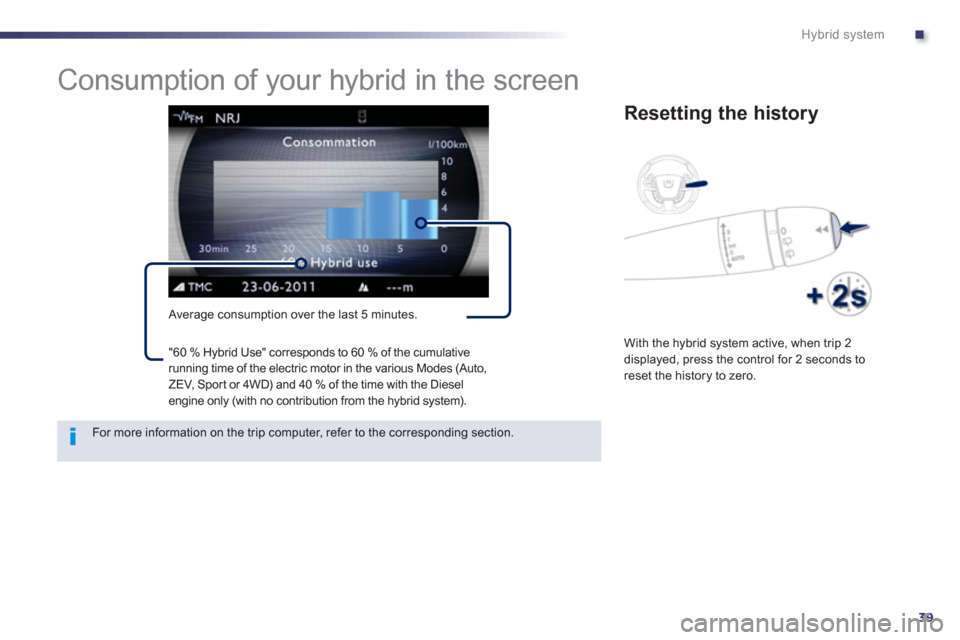
.
39
Hybrid system
Consumption of your hybrid in the screen
Average consumption over the last 5 minutes.
Resetting the history
With the hybrid system active, when trip 2displayed, press the control for 2 seconds to
reset the history to zero.
For more information on the trip computer, refer to the corresponding section. "60 % H
ybrid Use" corresponds to 60 % of the cumulative running time of the electric motor in the various Modes (Auto,
ZEV, Sport or 4WD) and 40 % of the time with the Dieselengine only (with no contribution from the hybrid system).
Page 42 of 304
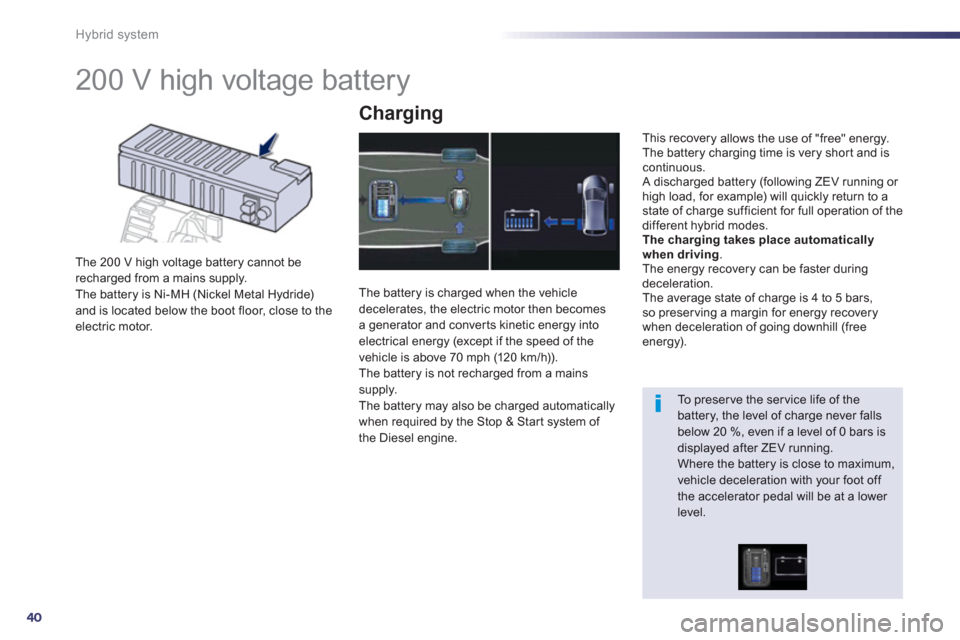
40
Hybrid system
200 V high voltage battery
The 200 V high voltage battery cannot berecharged from a mains supply.
The battery is Ni-MH (Nickel Metal Hydride) and is located below the boot floor, close to the electric motor.
Charging
The battery is charged when the vehicledecelerates, the electric motor then becomes
a generator and converts kinetic energy intoelectrical energy (except if the speed of the
vehicle is above 70 mph (120 km/h)).
The battery is not recharged from a mains
supply.
The battery may also be charged automatically
when required by the Stop & Star t system of
the Diesel engine.
This recover
y allows the use of "free" energy.
The battery charging time is very shor t and iscontinuous.
A discharged battery (following ZEV running or high load, for example) will quickly return to astate of charge sufficient for full operation of the
different hybrid modes.Thecharging takes place automatically
when driving.
The energy recovery can be faster during deceleration.
The average state of charge is 4 to 5 bars, so preser ving a margin for energy recovery
when deceleration of going downhill (freeenergy).
To preser ve the ser vice life of the battery, the level of charge never falls below 20 %, even if a level of 0 bars is displayed after ZEV running. Where the battery is close to maximum, vehicle deceleration with your foot off the accelerator pedal will be at a lower level.
Page 43 of 304
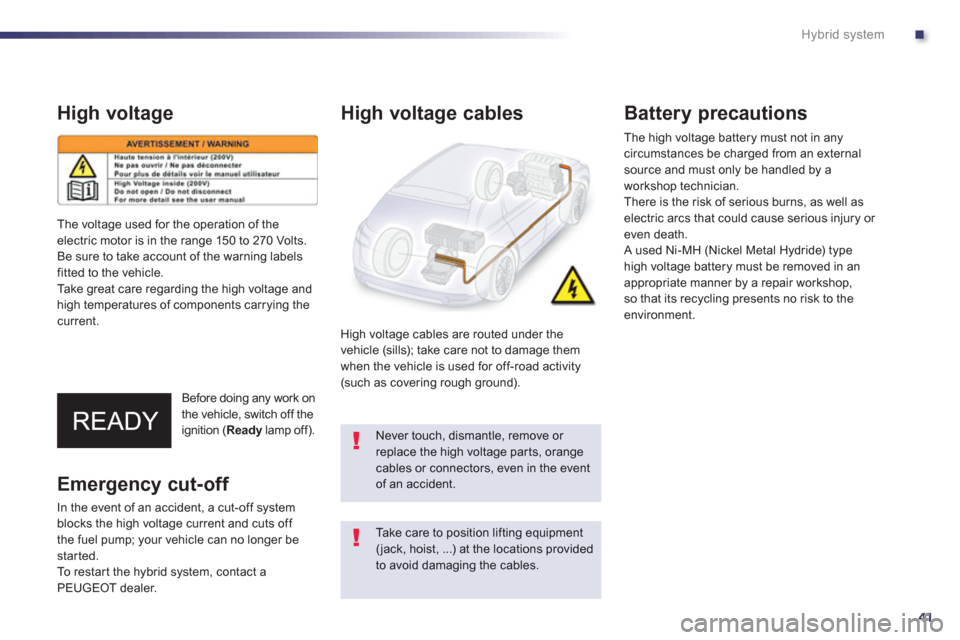
.
41
Hybrid system
High voltage
Before doing any work on
the vehicle, switch off the
ignition ( Ready lamp off).
y
High voltage cables
High voltage cables are routed under the
vehicle (sills); take care not to damage them when the vehicle is used for off-road activity (such as covering rough ground).
Battery precautions
The high voltage battery must not in anycircumstances be charged from an external
source and must only be handled by a
workshop technician.
There is the risk of serious burns
, as well as electric arcs that could cause serious injury or even death.
A used Ni-MH (Nickel Metal Hydride) type high voltage battery must be removed in an
appropriate manner by a repair workshop,so that its recycling presents no risk to the environment.
Take care to position lifting equipment(jack, hoist, ...) at the locations provided to avoid damaging the cables.
The volta
ge used for the operation of theelectric motor is in the range 150 to 270 Volts.
Be sure to take account of the warning labels
fitted to the vehicle.
Take great care regarding the high voltage and high temperatures of components carrying thecurrent.
Emergency cut-off
In the event of an accident, a cut-off system
blocks the high voltage current and cuts off
the fuel pump; your vehicle can no longer bestarted.
To restar t the hybrid system, contact a
PE
UGEOT dealer.
Never touch, dismantle, remove or replace the high voltage par ts, orange cables or connectors, even in the event of an accident.
Page 44 of 304
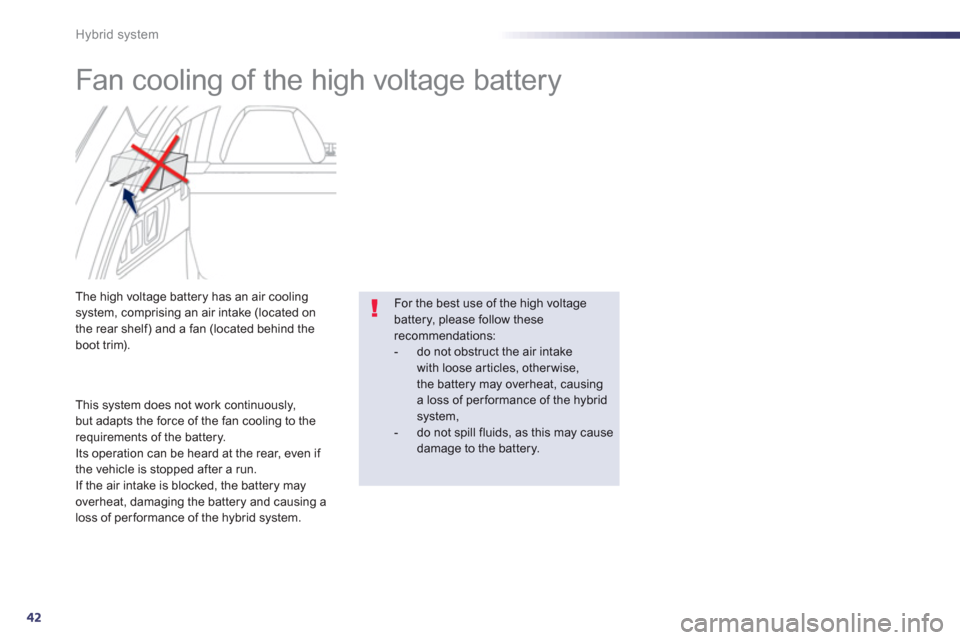
42
Hybrid system
Fan cooling of the high voltage battery
The high voltage battery has an air coolingsystem, comprising an air intake (located on
the rear shelf) and a fan (located behind the
boot trim).
This s
ystem does not work continuously,
but adapts the force of the fan cooling to the requirements of the battery.
Its operation can be heard at the rear, even if
the vehicle is stopped after a run.
If the air intake is blocked, the battery may
overheat, damaging the battery and causing a
loss of performance of the hybrid system.
For the best use of the high voltage battery, please follow these recommendations: - do not obstruct the air intakewith loose articles, otherwise, the battery may overheat, causinga loss of performance of the hybrid system ,- do not spill fluids, as this may causedamage to the battery.
Page 45 of 304
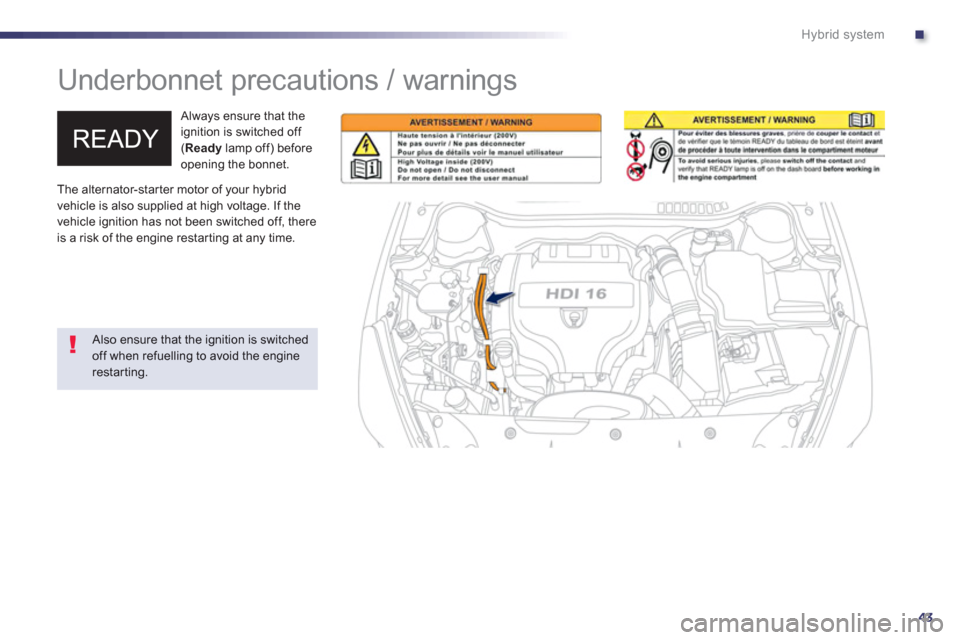
.
43
Hybrid system
Underbonnet precautions / warnings
Always ensure that the
ignition is switched off (Ready lamp off) before opening the bonnet.
The alternator-star ter motor of
your hybrid
vehicle is also supplied at high voltage. If the
vehicle ignition has not been switched off, there
is a risk o
f the engine restar ting at any time.
Also ensure that the ignition is switched off when refuelling to avoid the enginerestarting.
Page 46 of 304
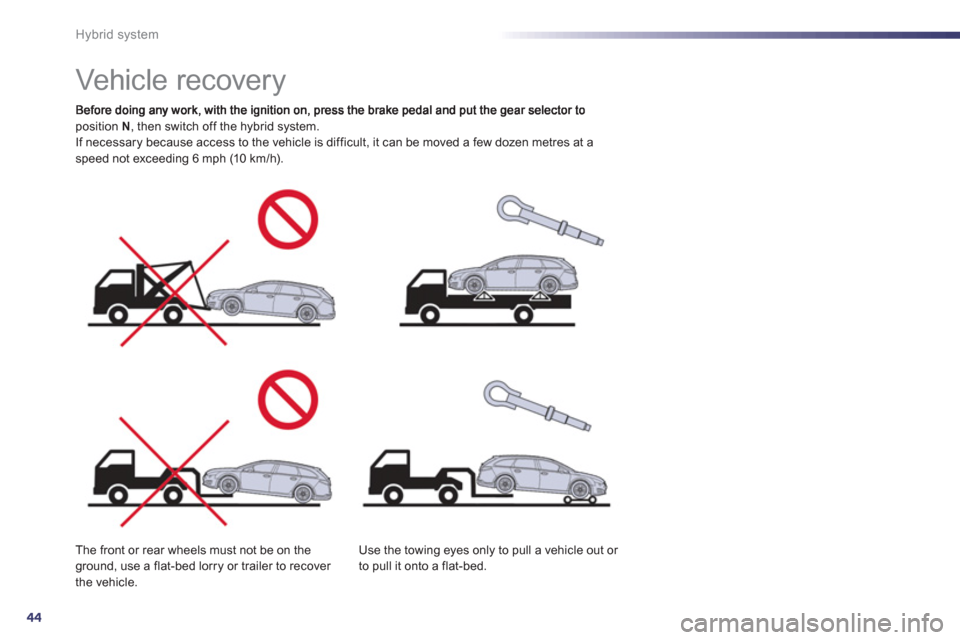
44
Hybrid system
Vehicle recovery
position N
, then switch off the hybrid system.
If necessary because access to the vehicle is difficult, it can be moved a few dozen metres at a speed not exceeding 6 mph (10 km/h).
Th
e front or rear wheels must not be on theground, use a flat-bed lorry or trailer to recover
the vehicle.
Use the towin
g eyes only to pull a vehicle out or
to pull it onto a flat-bed.
Page 47 of 304
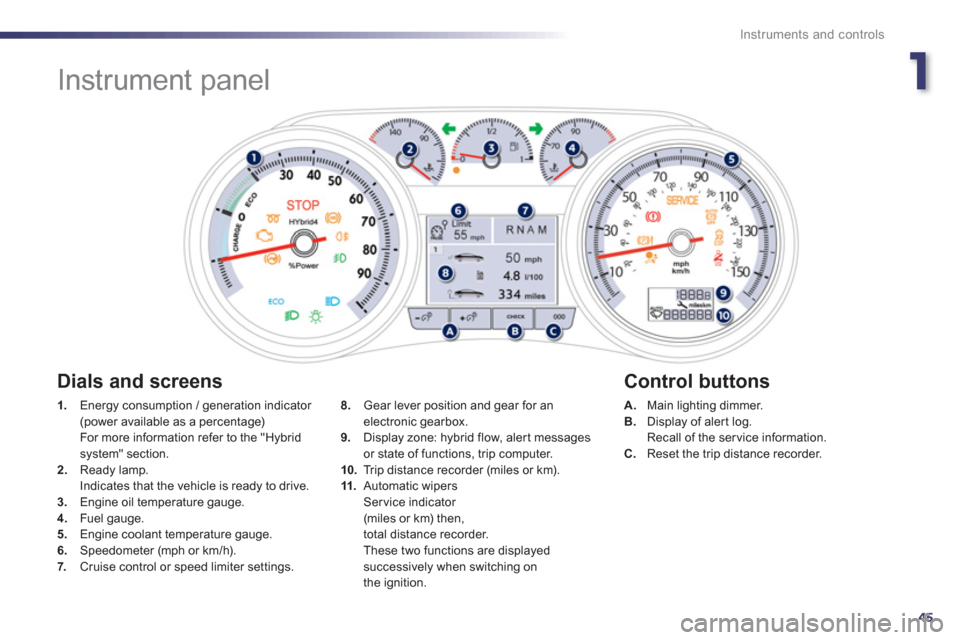
1
45
Instruments and controls
Instrument panel
1.
Energy consumption / generation indicator (power available as a percentage) For more information refer to the "Hybrid system" section. 2.Ready lamp.
Indicates that the vehicle is ready to drive. 3.Engine oil temperature gauge. 4. Fuel gauge.
5. Engine coolant temperature gauge.
6.Speedometer (mph or km/h).7. Cruise control or speed limiter settings.
A.Main lighting dimmer. B.
Display of aler t log.
Recall of the service information.
C. Reset the trip distance recorder.
8.
Gear lever position and gear for anelectronic gearbox. 9.
Display zone: hybrid flow, alert messages
or state of functions, trip computer.
10.Trip distance recorder (miles or km).
11.Automatic wipersSer vice indicator (miles or km) then,
total distance recorder.
These two functions are displayedsuccessively when switching on
the ignition.
Dials and screens
Control buttons
Page 48 of 304
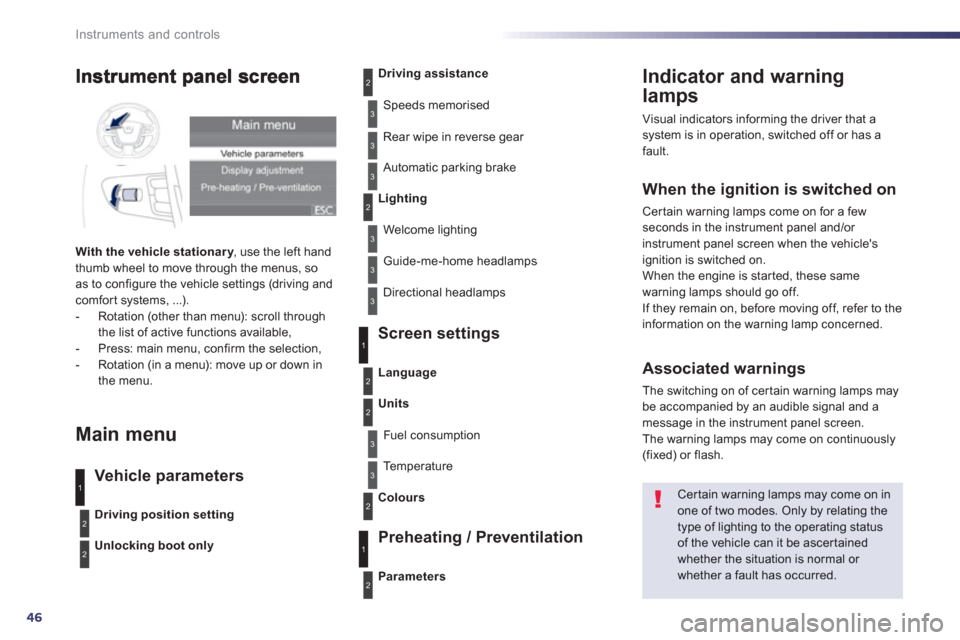
46
Instruments and controls
Indicator and warning
lamps
Visual indicators informing the driver that a system is in operation, switched off or has a
fault.
When the ignition is switched on
Certain warning lamps come on for a few seconds in the instrument panel and/or
instrument panel screen when the vehicle's
ignition is switched on.
When the engine is started, these same
warning lamps should go off.
If they remain on, before moving off, refer to the
information on the warning lamp concerned.
Associated warnings
The switching on of cer tain warning lamps maybe accompanied by an audible signal and a message in the instrument panel screen.
The warning lamps may come on continuously(fixed) or flash.
Certain warning lamps may come on inone of two modes. Only by relating thetype of lighting to the operating status
of the vehicle can it be ascertainedwhether the situation is normal or whether a fault has occurred.
1
2
2
2
3
3
3
2
3
3
With the vehicle stationar y
, use the left handythumb wheel to move through the menus, so as to configure the vehicle settings (driving andcomfort systems, ...).
- Rotation (other than menu): scroll through
the list of active functions available,
- Press: main menu, confirm the selection,
- Rotation (in a menu): move up or down in
the menu.
Main menu
Vehicle parameters Screen settin
gs
Preheatin
g / Preventilation
Driving position setting
Unlocking boot only
Driving assistance
Speeds memorised
Rear wipe in reverse
gear
Automatic parkin
g brake
Lighting
Welcome lighting
Guide-me-home headlamps
Directional headlamps
Parameters
Language
Units
Fuel consumption
Te m p e r a t u r e
Colours
3
1
2
2
3
2
3
1
2
Page 49 of 304
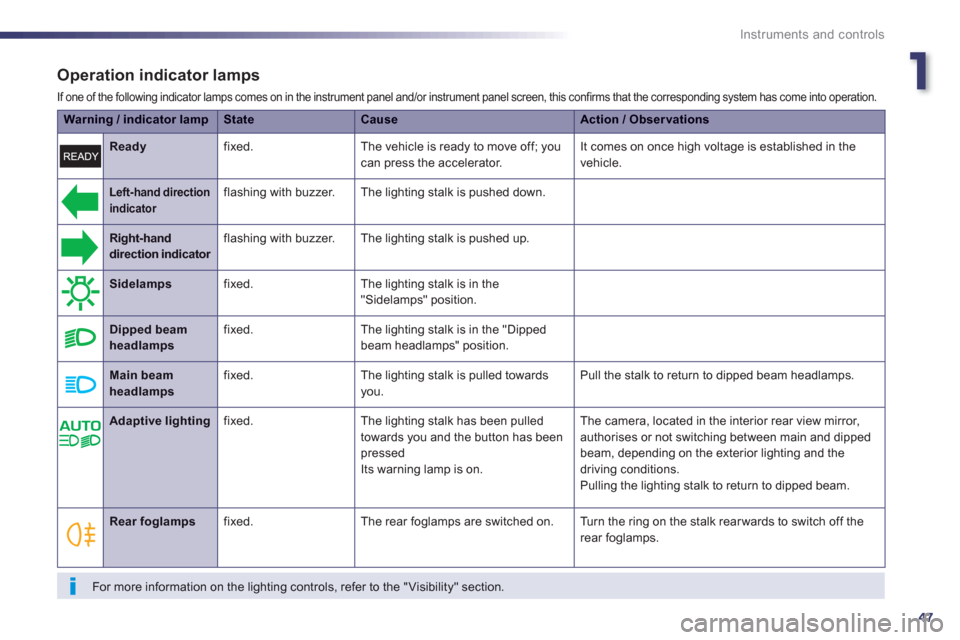
1
47
Instruments and controls
Operation indicator lamps
If one of the following indicator lamps comes on in the instrument panel and/or instrument panel screen, this confirms that the corresponding system has come into operation.
Warning / indicator lampStateCauseAction / Observations
Left-hand direction indicato
r
flashing with buzzer. The lighting stalk is pushed down.
Right-handdirection indicator flashing with buzzer. The lighting stalk is pushed up.
Sidelamps
fixed. The lighting stalk is in the
"Sidelamps" position.
Dipped beamheadlamps
fixed. The lighting stalk is in the "Dipped
beam headlamps" position.
Main beam headlamps fixed. The lighting stalk is pulled towards
you. Pull the stalk to return to dipped beam headlamps.
Ready fixed. The vehicle is ready to move off; you can press the accelerator. It comes on once high voltage is established in the
vehicle.
Rear foglamps
fixed. The rear foglamps are switched on. Turn the ring on the stalk rear wards to switch off the
rear foglamps.
For more information on the lighting controls, refer to the "Visibility" section.
Adaptive lighting
fixed. The lighting stalk has been pulled
towar
ds you and the button has been pressedIts warning lamp is on. The camera
, located in the interior rear view mirror,
authorises or not switching between main and dippedbeam, depending on the exterior lighting and thedriving conditions.
Pulling the lighting stalk to return to dipped beam.
Page 50 of 304
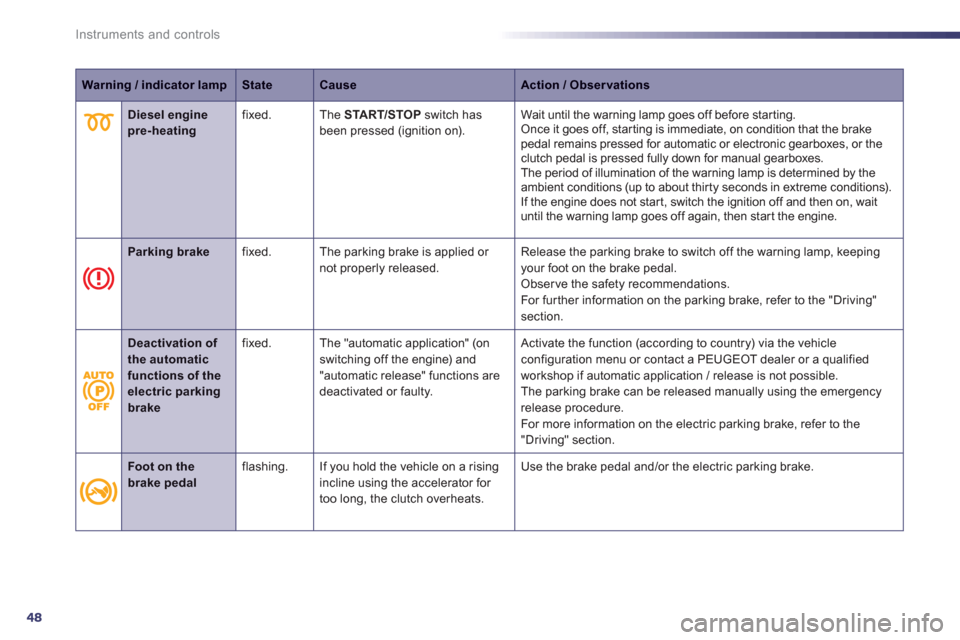
48
Instruments and controls
Warning / indicator lampStateCauseAction / Observations
Diesel engine pre-heatingfixed. The START/STOPswitch hasbeen pressed (ignition on).Wait until the warning lamp goes off before star ting. Once it goes off, starting is immediate, on condition that the brake pedal remains pressed for automatic or electronic gearboxes, or theclutch pedal is pressed fully down for manual gearboxes.
The period of illumination of the warning lamp is determined by theambient conditions (up to about thir ty seconds in extreme conditions).
If the engine does not star t, switch the ignition off and then on, wait until the warning lamp goes off again, then start the engine.
Parking brakefixed. The parking brake is applied or
not properly released.Release the parking brake to switch off the warning lamp, keepingyour foot on the brake pedal. Observe the safety recommendations.
For fur ther information on the parking brake, refer to the "Driving"section.
Deactivation of the automatic functions of the electric parkingbrake
fixed. The "automatic application" (on switching off the engine) and"automatic release" functions are
deactivated or faulty. Activate the function
(according to country) via the vehicle configuration menu or contact a PEUGEOT dealer or a qualified workshop if automatic application / release is not possible.
The parking brake can be released manually using the emergencyrelease procedure.
For more information on the electric parking brake, refer to the "Driving" section.
Foot on thebrake pedalflashing. If you hold the vehicle on a risingincline using the accelerator for
too long, the clutch overheats.Use the brake pedal and
/or the electric parking brake.